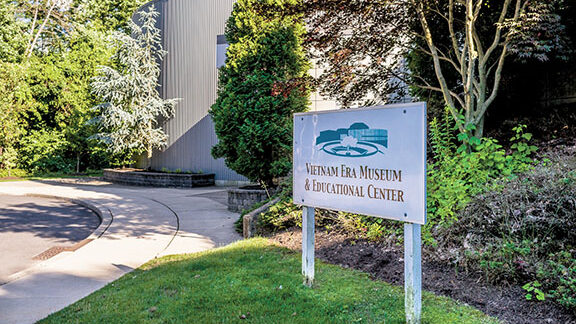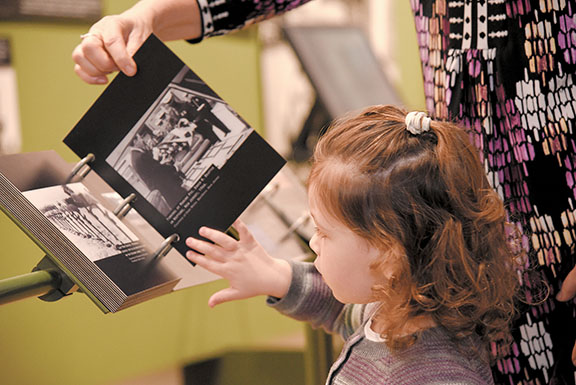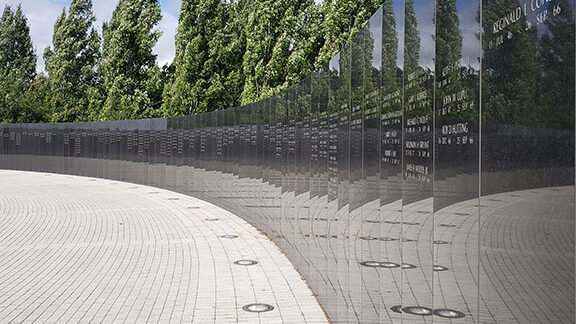
By Melissa Ziobro
HOLMDEL – March 29 is known as National Vietnam War Veterans Day because on that date in 1973, the Military Assistance Command, Vietnam (MACV) disbanded and the last U.S. combat troops departed the Republic of Vietnam.
The Department of Veterans Affairs recently noted that more than 9 million Americans served in the military during the Vietnam War era – from Nov. 1, 1955 to May 15, 1975. The National Archives show 58,220 U.S. military fatalities during the Vietnam War. But some 6 million of the men and women who served during this era are still living.
How do we honor those we lost? Remember those who served and were forever changed by their involvement? Extract lessons from this wrenching experience?
The New Jersey Vietnam Veterans’ Memorial Foundation (NJVVMF) is committed to sharing the experiences of the Vietnam War Era and its enduring legacy with future generations. The foundation oversees the NJ Vietnam Veterans’ Memorial and the Vietnam Era Museum. The memorial recognizes the valor of New Jersey’s veterans specifically, and the sacrifices of their families and communities. The museum, however, is not singularly focused on the state of New Jersey. It teaches the entirety of the Vietnam War Era through inclusive and objective exhibitions. The memorial and museum are both conveniently located off exit 116 on the Garden State Parkway.
The Memorial
The New Jersey Vietnam Veterans’ Memorial honors all those from the state who served during the Vietnam War, especially the 1,562 New Jersey men and one woman who never returned home. Their names are listed individually by date of casualty on the memorial.
The dedication of the national Vietnam Veterans Memorial in Washington, D.C. in 1982 inspired a group of New Jersey veterans in attendance to undertake commemoration efforts in their state. This grassroots endeavor took a giant leap forward Jan. 12, 1986 when Gov. Thomas Kean signed a bill creating the 14-member New Jersey Vietnam Veterans’ Memorial Commission within the Department of State. The commission’s charge was threefold: select an appropriate memorial site, select a meaningful design and raise the funds to build it.
The commission selected a 5.5-acre site in Holmdel Township, drawn to the serene and tranquil rolling hills in the area. The site, shared today with the PNC Bank Arts Center, has direct access to the Garden State Parkway.
The next step was to choose a design for the memorial. A statewide design competition ran through the summer of 1988 and drew 421 entries. The winning design was submitted by Hien Nguyen, a naturalized American citizen who had left Vietnam 13 years earlier.
Nguyen designed a 200-foot diameter open-air pavilion. Lined with 366 black granite panels on which the names of those from New Jersey who died or remain missing in action are engraved, the panels form a circle meant to enfold visitors in an embrace. The highly polished granite wall reflects the visitor, creating a powerful union between past and present. The memorial is accessed via tunnels, symbolizing the transition from the safety and security of the civilian world to the very different realities of war. The trees lining the walkways to the entrance evoke images of soldiers on tactical patrol throughout the dangerous countryside. At the center of the pavilion stands the red oak, New Jersey’s state tree. The memorial was officially opened following its dedication May 7, 1995.
The campus is now also home to several smaller, but no less moving monuments, such as the War Dogs Memorial, Purple Heart Memorial, NJ Gold Star Family Monument and Vietnamese American Monument.

The Museum
In 1993, the foundation expanded its mission to focus on educating the public about this complex historic era, hiring Ralph Appelbaum and Associates, renowned for designing the U.S. Holocaust Memorial Museum. On Sept. 27, 1998, Gov. Christine Todd Whitman and famed former POW Sen. John McCain joined a large crowd to dedicate the Vietnam Era Museum.
The museum features a chronology of the era, shown in two concurrent timelines on its walls – one reflecting the activity in Vietnam and the other reflecting political, cultural and historical events in the United States. This allows visitors to gain a fuller perspective of the political, military, social and cultural elements in play during this time. Interspersed along this timeline are touch-screen kiosks that provide visitors with an interactive glance at historical events.
Complementing the timeline are artifacts, photographs and letters which share the personal experiences of those who served and their supporters back home, humanizing the war and its lasting effects on peoples’ lives.
At the center of the museum is the Testimony Theater, where Vietnam veterans share their experiences.
Temporary exhibits are featured in the theater area and lobby of the museum. These change two to three times each year and focus on a variety of topics related to the Vietnam Era.
Navigating a Pandemic
COVID-19 put many museums in a precarious situation. The New Jersey Vietnam Veterans’ Memorial and all outdoor monuments remained open throughout; however, the museum was forced to close temporarily. Staff quickly identified ways to execute their mission while ensuring the safety of their Vietnam veteran volunteers and guests. These efforts included the creation of a virtual interview series, “VetChat,” which gives viewers a front row seat to an intimate conversation with one of the NJVVMF’s Vietnam Veteran volunteers.
An online version of the temporary exhibit, “As You Were: Stephen Warner (Words and Images from Vietnam),” was created to ensure that new content was available to the public in some form. It is still available online. Warner, a conscientious objector, received his draft notice in June 1969. He was conflicted about serving in a war that he didn’t believe in, but decided to make the best of his time in the military. The photographs featured in the exhibition were all taken by Warner, from Skillman, New Jersey, during his tour of duty in Vietnam from March 1970 through his death there in February 1971. The exhibition includes letters written to his parents, including an excerpt from the letter he sent just one week before he was killed in action.

Making a Visit
The New Jersey Vietnam Veterans’ Memorial and all outdoor monuments are currently open to the public, at no cost, 24 hours a day, 7 days a week. The museum is now open from 10 a.m. to 4 p.m. Tuesday through Saturday. Admission is $7 for adults and $5 for students and seniors. Veterans, active duty personnel and children under 12 are free. Visitors are encouraged to visit NJVVMF’s website at njvvmf.org or the organization’s Facebook and Twitter pages which are regularly updated with virtual content and information about activities.
Melissa Ziobro is a specialist professor of public history at Monmouth University’s Department of History and Anthropology.
The article originally appeared in the March 24 – 30, 2022 print edition of The Two River Times.
















